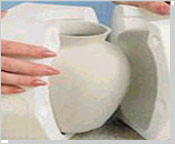 This process use a method very near to plaster mold casting. Plaster, plastic, wood, metal or rubber is used for making the pattern.
This process use a method very near to plaster mold casting. Plaster, plastic, wood, metal or rubber is used for making the pattern.
A ceramic slurry comprising zircon, fused silica and a bonding agent is first poured over the pattern. Like rubber it hardens quickly. It is then peeled of the pattern and reassembled as a mold. The volatile materials are removed in a low temperature oven. Ceramic mold, with high temperature pours is obtained after it is baked in a furnace at about 1000 °C (1832 °F) .
Features of Ceramic Mold Casting- Tolerances: 0.4 %,
- Surface finish: 2 - 4 µm (.075 - .15 µin)
- Wall thickness: may be as small as 1.25 mm (.050 in),
- Weights: Range from 60 g (2oz) to a 1000kg
- Draft allowance: 1° recommended.
- Patterns: Reusable and cheap.
- Casting size: generally not restricted except above 100 lb
Ceramic Mold Casting can be performed by two distinct procedures:
True Ceramic Molding: Here, the refractory grain is first bonded with calcium or ammonium phosphates. The ceramic molds are generally made by the dry pressing method. Where molds are made by pressing clay mixture with some percentage of moisture in dies under a pressure of 1-10 ton/sq inch. The mold is finally ready after they are stripped from the dies and baked in a furnace at temperatures that range between 1650-2400°F (899°C and 1316°C).
Shaw Process: Shaw process or the Ethyl silicate variation takes place in the following way. A consistent slurry is made by blending together a mixture of graded refractory filler, hydrolyzed ethyl silicate, and a liquid catalyst. It is then poured in the pattern and allowed to jell. After this, the mold is stripped and heated using a high pressure gas torch. It is then cooled, assembled and fired before pouring is done. Some times the Shaw process and the lost wax process are used in combination to gain the advantages of both the processes.
Application of Ceramic Mold CastingParts made from this process include impellers, complex cutting tools, plastic mold tooling etc.
